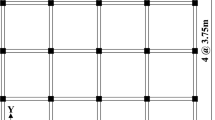Abstract
Ground motion intensity measure (IM) is an important part in performance-based seismic design. A reasonable and efficient IM can make the prediction of the structural seismic responses more accurate. Therefore, a more reasonable IM for super high-rise buildings is proposed in this paper. This IM takes into account the significant characteristic that higher-order vibration modes play important roles in the seismic response of super high-rise buildings, as well as the advantages of some existing IMs. The key parameter of the proposed IM is calibrated using a series of time-history analyses. The collapse simulations of two super high-rise buildings are used to discuss the suitability of the proposed IM and some other existing IMs. The results indicate that the proposed IM yields a smaller coefficient of variation for the critical collapse status than other existing IMs and performs well in reflecting the contribution of higher-order vibration modes to the structural response. Hence, the proposed IM is more applicable to seismic design for super high-rise buildings than other IMs.
Similar content being viewed by others
References
Hamburger R, Rojahn C, Moehle J, et al. The ATC-58project: Development of next-generation performance-based earthquake engineering design criteria for buildings. In: 13th World Conference on Earthquake Engineering, Vancouver, B.C., Canada, August 1–6, 2004. 1819
Shome N, Cornell C A, Bazzurro P, et al. Earthquakes, records and nonlinear responses. Earthq Spectra, 1998, 14: 469–500
Tothong P, Luco N. Probabilistic seismic demand analysis using advanced intensity measures. Earthquake Eng Struct Dyn, 2007, 36: 1837–1860
Cordova P P, Deierlein G G, Mehanny S S F, et al. Development of a two-parameter seismic intensity measure and probabilistic assessment procedure. In: The Second U.S.-Japan Workshop on Performance-based Earthquake Engineering Methodology for Reinforced Concrete Building Structures, Sapporo, Japan, 2001. 187–206
Luco N, Cornell C A. Structure-specific scalar intensity measures for near-source and ordinary earthquake motions. Earthq Spectra, 2007, 23: 357–391
Baker J W, Cornell C A. A vectored-valued ground motion intensity measure consisting of spectral acceleration and epsilon. Earthquake Eng Struct Dyn, 2005, 34: 1193–1217
Vamvatsikos D, Cornell C A. Incremental dynamic analysis. Earthquake Eng Struct Dyn, 2002, 31: 491–514
Ye L P, Ma Q L, Miao Z W, et al. Numerical and comparative study of earthquake intensity indices in seismic analysis. Struct Des Tall Spec, 2013, 22: 362–381
Lucchini A, Mollaioli F, Monti G. Intensity measures for response prediction of a torsional building subjected to bi-directional earthquake ground motion. B Earthq Eng, 2011, 9: 1499–1518
Jiang H J, He L S, Lu X L, et al. Analysis of seismic performance and shaking table tests of the Shanghai Tower (in Chinese). J Building Struct, 2011, 32: 55–63
Yang X Q, Fu X Y, Huang Y J. Dynamic elasto-plastic analysis of the Shenzhen Ping’an Financial Center Tower (in Chinese). J Building Structs, 2011, 32: 40–49
Fan H, Li Q S, Alex Y T, et al. Seismic analysis of the world’s tallest building. J Construct Steel Res, 2009, 65: 1206–1215
Miranda E, Taghavi S. Approximate floor acceleration demands in multistory buildings I: Formulation. J Struct Eng-ASCE, 2005, 131: 203–211
Lu X, Lu X Z, Ye L P, et al. Collapse analysis of super high-rise building and discussion on the ground motion intensity measures. In: 15th World Conference on Earthquake Engineering, Lisbon, Portugal, September 24–28, 2012. 0164
FEMA. Quantification of building seismic performance factors, FEMA P695. Applied Technology Council, Redwood City, C.A., 2009
Lu X, Lu X Z, Zhang W K, et al. Collapse simulation of a super high-rise building subjected to extremely strong earthquakes. Sci China Tech Sci, 2011, 54: 2549–2560
Ding J M, Wu H L, Zhao X. Seismic performance analysis and evaluation of Shanghai Tower under Maximum Considered Earthquake (in Chinese). J Civil Architect Environ Eng, 2010, 32: 231–233
Miranda E, Akkar S D. Generalized interstory drift spectrum. J Struct Eng-ASCE, 2006, 132: 840–852
Miranda E, Aslani H. Probabilistic response assessment for building-specific loss estimation. PEER 2003/03, Pacific Earthquake Engineering Research Center, University of California at Berkeley, Berkeley, CA, 2003
Shi W, Lu X Z, Ye L P. Uniform-risk-targeted seismic design for collapse safety of building structures. Sci China Tech Sci, 2012, 55: 1481–1488
Lu X Z, Zhang W K, Lu X, et al. Elasto-plastic mechanical behavior of detailed finite element model and simplified model of mega columns (in Chinese). J Shenyang Jianzhu University (Natural of Science), 2011, 27: 409–417
Lu X, Lu X Z, Guan H, et al. Collapse simulation of reinforced concrete high-rise building induced by extreme earthquakes. Earthquake Eng Struct Dyn, 2013, 42: 705–723
Lu X Z, Lu X, Guan H, et al. Earthquake-induced collapse simulation of a super-tall mega-braced frame-core tube building. J Constr Steel Res, 2013, 82: 59–71
Lu X, Lu X Z, Ye L P. Discussion on the ground motion intensity measures for super high-rise buildings (in Chinese). China Civil Eng J, 2012, 45: 292–296
Author information
Authors and Affiliations
Corresponding author
Rights and permissions
About this article
Cite this article
Lu, X., Ye, L., Lu, X. et al. An improved ground motion intensity measure for super high-rise buildings. Sci. China Technol. Sci. 56, 1525–1533 (2013). https://doi.org/10.1007/s11431-013-5234-1
Received:
Accepted:
Published:
Issue Date:
DOI: https://doi.org/10.1007/s11431-013-5234-1




